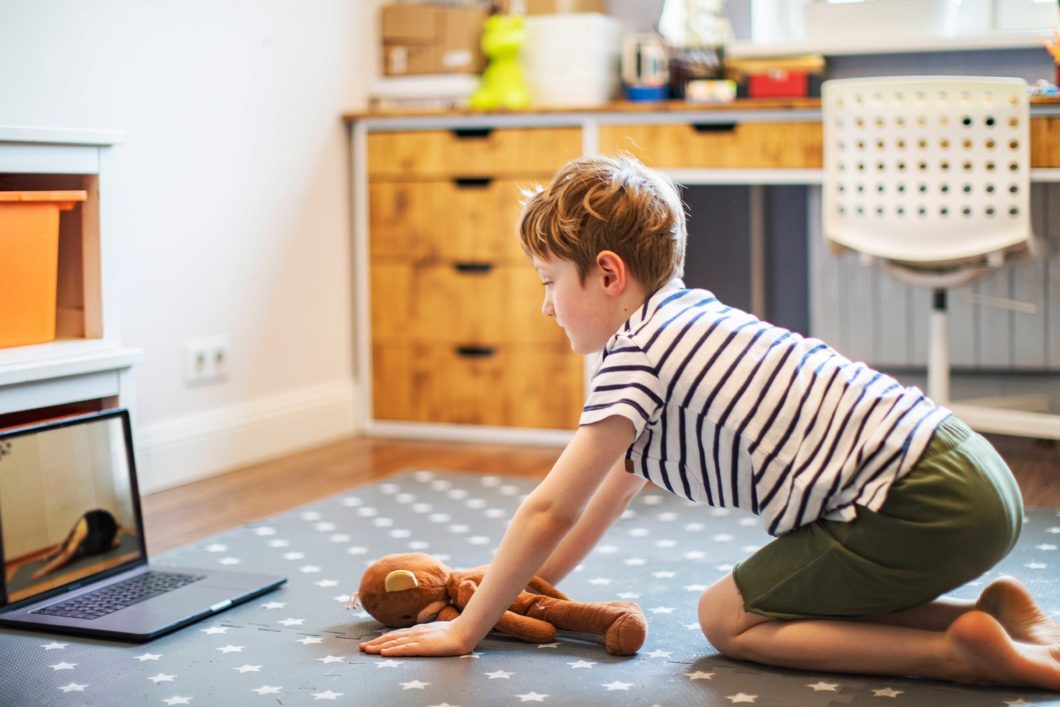As grad school clinicians during COVID-19, many of us have had the opportunity to utilize telepractice to provide speech therapy to our clients. This has changed almost everything about our sessions—especially those with pediatric clients. We’re no longer physically in the room with these kids, which means we’re unable to move and play with them like we would in person.
So, how do we bring movement back into our therapy sessions?
Combining My Love of Yoga and Speech-Language Pathology
When I entered grad school, I knew I wanted to use my experience as a yoga instructor to support my career as an SLP.
I looked to SLPs like Carrie Clark, CCC-SLP, and Christine Ristuccia, CCC-SLP, to see exactly how they use yoga to encourage social communication and speech and language development, including:
- physical health and behavioral stability,
- inclusivity for every participant,
- developing decoding skills and metacognition,
- learning to improve fluency,
- learning new vocabulary (body, direction, movement, etc.), and
- developing syntactic and discourse knowledge.
Yoga and Speech and Language Therapy Online
While I’ve been developing ways to make speech therapy successful online during my teletherapy sessions, I’ve found it’s important now more than ever to incorporate movement into my sessions. The COVID-19 pandemic has made it possible and, in some cases, necessary to find ways to navigate doing therapy online. Using yoga as a method for including movement as part of your virtual sessions can enhance the quality of your therapy and encourage your pediatric clients to participate.
Consider the difficulty you might face with those speech kiddos sitting at their computer with no outlet for their wiggles. Kids need to move and express themselves physically. If you don’t give them the opportunity to move, they can become irritable and lose interest quickly. Yoga exercises can be a fun and rewarding way to release energy, increase motivation, and alleviate stress.
Say you’re teaching the /s/ sound, you can ask your kiddo to lay on the floor and act like a snake while they ‘hisssss’ or strike the cobra pose while they repeat as many s-words as they can. Tree pose is a favorite of mine to increase concentration and balance with the added challenge of articulating sounds in words. I ask my kiddos, “How many words can you say before you lose your balance?” They become motived by the challenge and are more focused on holding their pose than over-thinking their articulation.
Sometimes, they surprise themselves by making the sound easier when standing in a funny position. One of my favorite clients had so much fun practicing /r/ words while standing on one leg, he actually did better than when he was sitting in the chair!
Before you know it, you’ll be moving, breathing, giggling, and articulating with them. In the same way that we collaborate with our clients on Zoom using whiteboard and annotation, we can collaborate and communicate with our clients using yoga and movement as our expression.
Resources to Help Incorporate Yoga Into Speech Therapy
If you’re interested in incorporating yoga into your therapy sessions, I have a few resources I recommend checking out:
- Say It Right offers yoga cards for language development and support for yoga and speech-language pathology.
- Speech and Language Kids (by the SLP Solution) provides tons of resources to assist in planning and teaching yoga during speech and therapy, including books on yoga poses (with pictures) that can be used during teletherapy.
- Tandem Speech Therapy shares info about how yoga poses can be used to teach vocabulary, listening skills, and breathing techniques.
- Stories, Songs, and Stretches: Creating Playful Storytimes with Yoga and Movement is a wonderful book to spark ideas for integrating yoga into literacy.
For those of us who are fortunate enough to deliver speech therapy services through telework, we’ve been given a rare opportunity to creatively make movement part of our therapy sessions. Challenge yourself, your kiddos, and even their parents, to get up and move at a time when we’re all stuck in front of a screen. Computer screens can’t hold us back!

